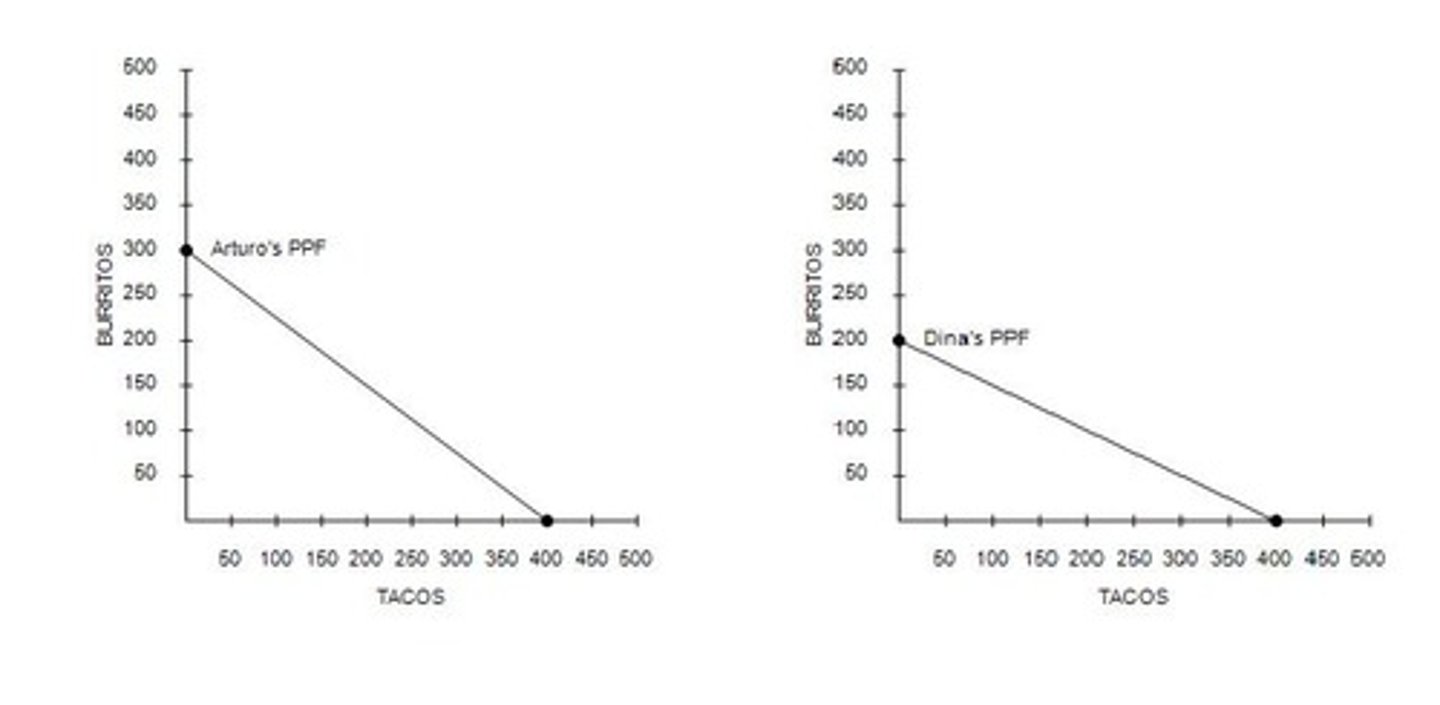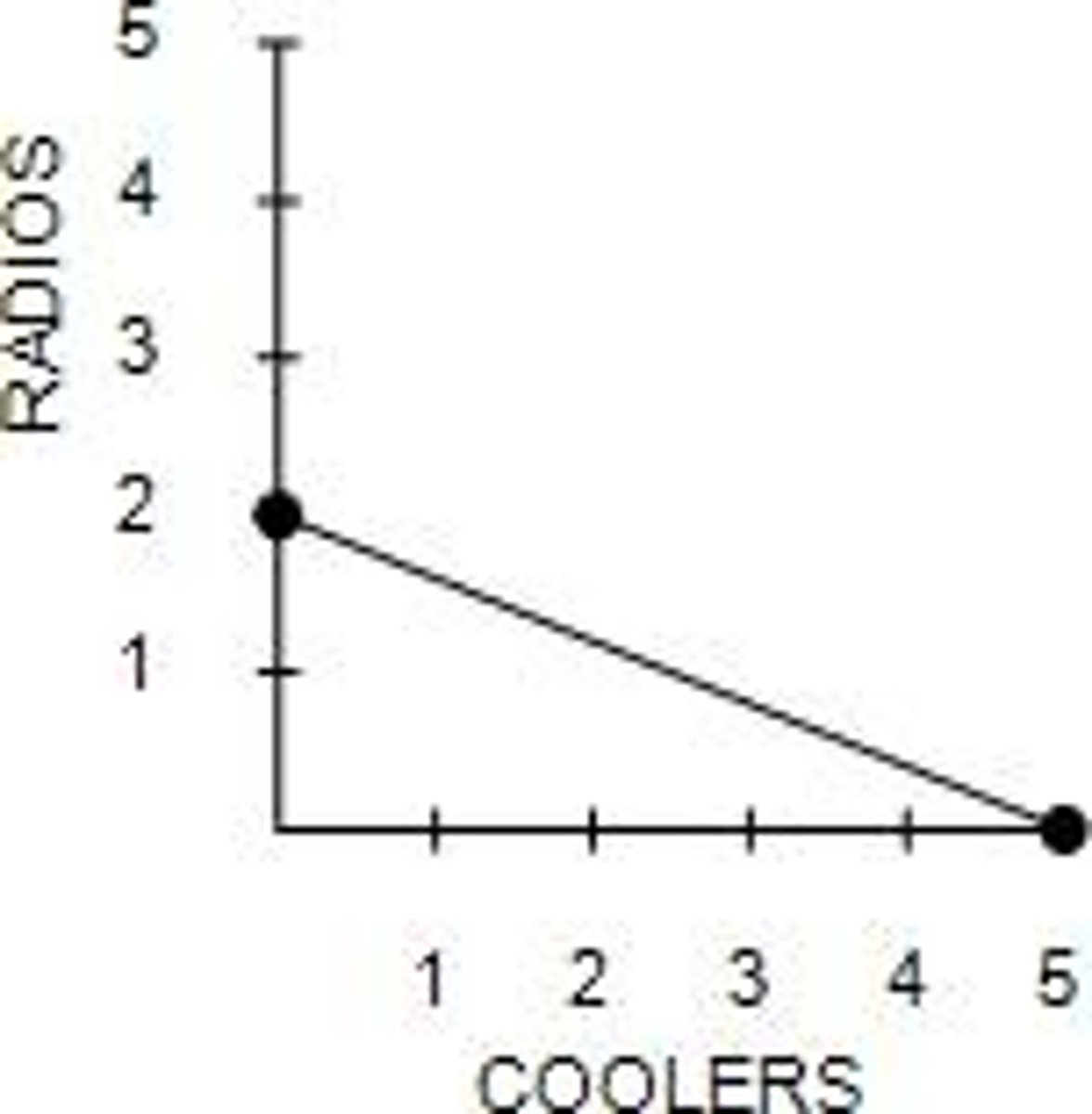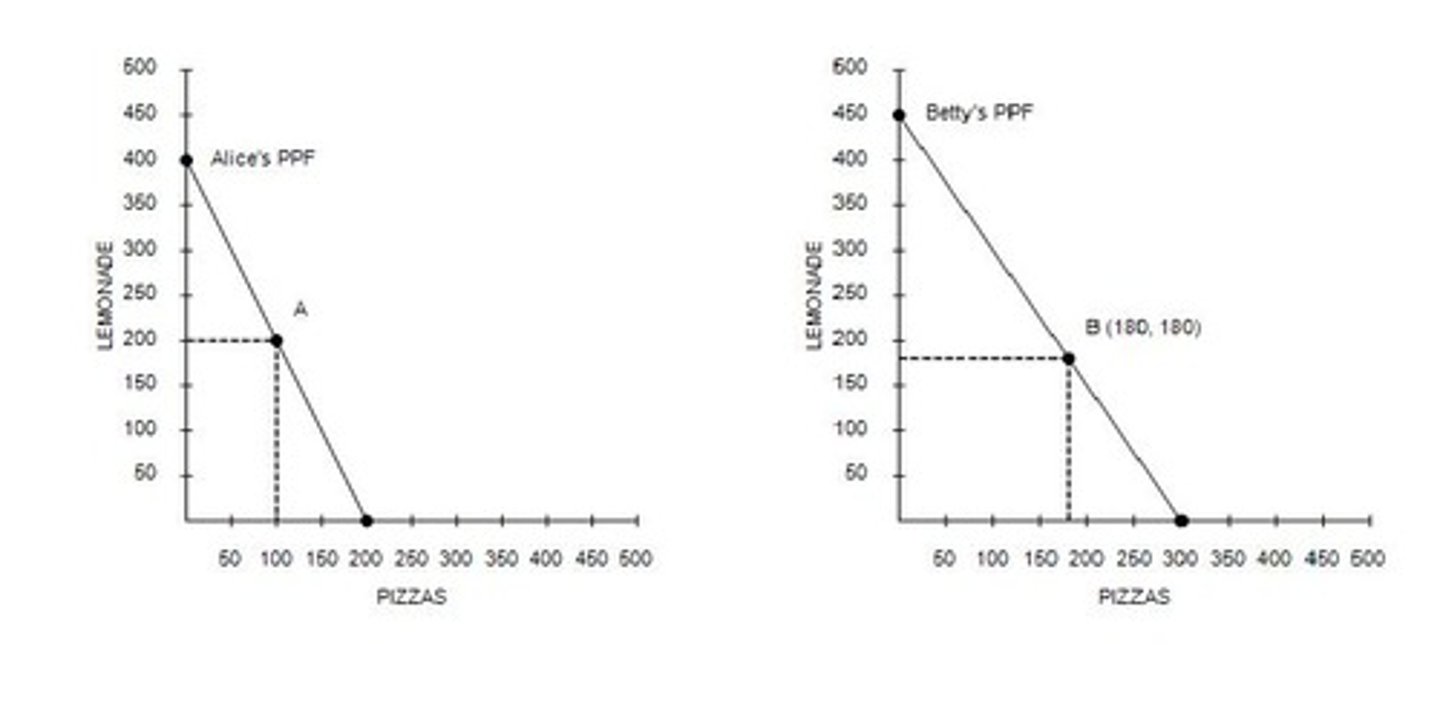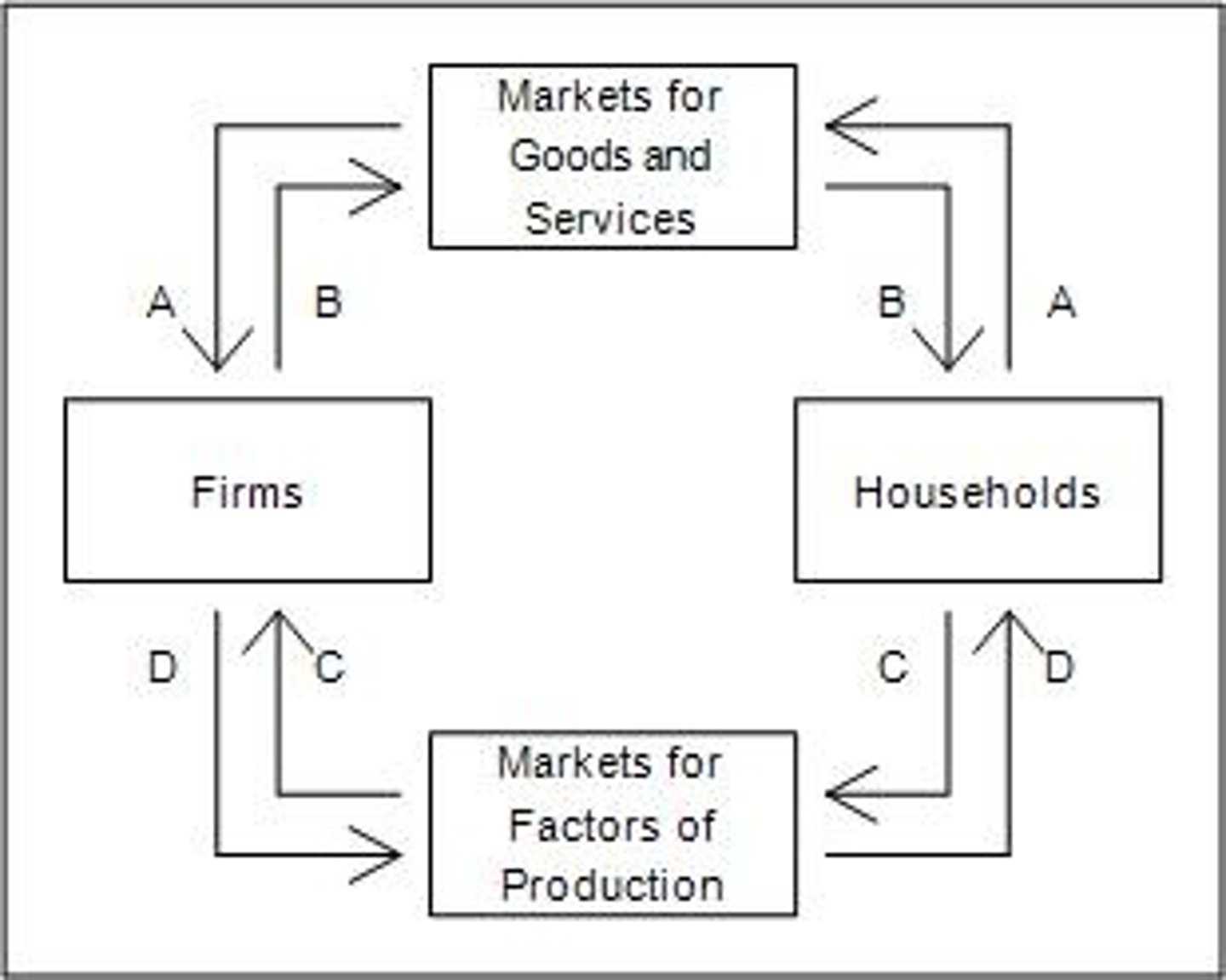Understanding Comparative Advantage and Trade in Economics
1/108
There's no tags or description
Looks like no tags are added yet.
Name | Mastery | Learn | Test | Matching | Spaced |
|---|
No study sessions yet.
109 Terms
Absolute advantage
Found by comparing different producers' opportunity costs, payments to land, labor, and capital, input requirements per unit of output, and locational and logistical circumstances.
Comparative advantage
The producer that requires a smaller quantity of inputs to produce a certain amount of a good, relative to the quantities of inputs required by other producers to produce the same amount of that good.
Opportunity cost
The cost of forgoing the next best alternative when making a decision.
Trade benefits
Trade can make everybody better off because it allows people to specialize according to comparative advantage.
Production output example
In one day, Jamaica can produce 12 coolers or 6 radios, while Norway can produce 24 coolers or 3 radios.
Increased output from specialization
When Jamaica and Norway specialize in the good in which they have a comparative advantage, the total output of radios increased by 12.
Opportunity cost of production
If Peru increases its production of emeralds by 2, the opportunity cost of this decision is 60 rubies.

Indonesia's opportunity cost
Indonesia's opportunity cost of producing bananas is 2.5 units of rice, which is lower than India's opportunity cost of producing bananas.
Country's production strategy
When a country has a comparative advantage in producing a certain good, it should specialize in that good and trade for other goods.
Free trade principle
The principle of comparative advantage applies to countries as well as to individuals.
Comparative advantage and resources
Comparative advantage is determined by which person or group of persons can produce a given quantity of a good using the fewest resources.
Specialization and trade
Specializing in the production of a good and trading for other goods could allow a country to consume at a point beyond its production possibilities frontier.
Economists' use of comparative advantage
Economists use the principle of comparative advantage to emphasize the potential benefits of free trade.
Production possibilities frontier
A graphical representation of the maximum output possibilities for two goods, given a set of inputs.

Labor hours for production
In 40 hours, Indonesia can produce 20 units of rice or 8 units of bananas, while India can produce 10 units of rice or 20 units of bananas.
Resource allocation
Trade increases cooperation among nations.
Domestic competition
Trade reduces competition among domestic companies.
Retraining workers
Trade requires some workers in an economy to be retrained.
Input requirements
Input requirements per unit of output are crucial for determining absolute advantage.
Logistical circumstances
Locational and logistical circumstances can influence a producer's absolute advantage.
Economic cooperation
Increased cooperation among nations is a benefit of trade.
Production efficiency
A country may have a comparative advantage in producing a good, even though it lacks an absolute advantage in producing that good.
Specialization benefits
Allowing specialization according to comparative advantage can enhance overall production efficiency.
Production Possibilities Frontier
Illustrates the combinations of output that an economy can produce.

Specialization and Trade
Allow us to consume more goods than we otherwise would be able to consume.
Celia and Ryan's Trade
Trade could benefit both Celia and Ryan.
John and Jane's Production
If Jane spends 21 hours producing wine and 3 hours producing bread, and John spends 3 hours producing wine and 21 hours producing bread, the total production of bread falls and the total production of wine rises.
Table 3-1 Production
If each person spends 12 hours producing each good, the total production changes based on their allocation of hours.
England and France Production
If each country divides its time equally between the production of cheese and wine, total production is 24 units of cheese and 15 units of wine.
Aruba and Iceland Production
If each country divides its time equally between the production of coolers and radios, total production is 30 coolers and 9 radios.
Labor Hours for Wine and Bread
Jane needs 2 hours to make 1 bottle of wine and 1.5 hours to make 1 loaf of bread; John needs 3 hours for wine and 1 hour for bread.
Total Production of Cheese and Wine
If England and France each has 40 labor hours available, total production is 40 units of cheese and 20 units of wine.
Aruba's Production Possibilities Frontier
Represents the trade-off between producing coolers and radios when 100 labor hours are available.

Celia's Production
Celia produces hair clips and earrings but is less efficient than Ryan.
Benefit of Specialization
The most obvious benefit of specialization and trade is that they allow us to consume more goods.
Trade Benefits
Trade can benefit one party without benefiting the other.
Production Allocation
Changing the allocation of production hours can affect total output.
Labor Hours Needed
Aruba needs 2 hours to make a cooler and 5 hours for a radio; Iceland needs 1 hour for a cooler and 4 hours for a radio.
Total Production Changes
Total production can rise or fall based on how labor hours are allocated.
Production Units
The number of units produced in 40 hours varies based on labor hours needed.
Trade-off in Production
The production possibilities frontier illustrates the trade-offs in production choices.
Constant Rate of Production
John and Jane can switch between producing bread and wine at a constant rate.
Production Efficiency
Ryan is better at producing both hair clips and earrings than Celia.
Economic Consumption
The combinations of output that an economy should consume are not illustrated by the production possibilities frontier.
Labor Hours for Cheese and Wine
England requires 1 hour for cheese and 4 hours for wine; France requires 5 hours for cheese and 2 hours for wine.
Production Possibilities
The production possibilities frontier shows the maximum output combinations.
Zimbabwe's machine minutes for toothbrushes
3 machine minutes needed to make 1 toothbrush.
Zimbabwe's machine minutes for hairbrushes
10 machine minutes needed to make 1 hairbrush.
Portugal's machine minutes for toothbrushes
5 machine minutes needed to make 1 toothbrush.
Portugal's machine minutes for hairbrushes
6 machine minutes needed to make 1 hairbrush.
Total production if divided equally
24 toothbrushes and 12 hairbrushes.
Total production if divided equally
48 toothbrushes and 24 hairbrushes.
Total production if divided equally
96 toothbrushes and 48 hairbrushes.
Total production if divided equally
720 toothbrushes and 1440 hairbrushes.
Trade-off in Figure 3-2
Brazil faces a trade-off between producing peanuts and producing cashews.

Time to make one pound of peanuts
1/10 hour.
Time to make one pound of peanuts
1/3 hour.
Time to make one pound of peanuts
3 hours.
Time to make one pound of peanuts
10 hours.
Production possibilities in two months
7 pounds of peanuts and 135 pounds of cashews.
Production possibilities in two months
5 pounds of peanuts and 150 pounds of cashews.
Production possibilities in two months
2 pounds of peanuts and 240 pounds of cashews.
Production possibilities in two months
3 pounds of peanuts and 150 pounds of cashews.
Time to make one burrito in Figure 3-3
1/4 hour.
Time to make one burrito in Figure 3-3
1/3 hour.
Time to make one burrito in Figure 3-3
3 hours.
Time to make one burrito in Figure 3-3
4 hours.
Total production of tacos and burritos
200 tacos and 150 burritos.
Total production of tacos and burritos
400 tacos and 250 burritos.
Total production of tacos and burritos
400 tacos and 300 burritos.
Total production of tacos and burritos
800 tacos and 500 burritos.
Trade-off in Figure 3-4
Both Alice and Betty face a constant trade-off between producing pitchers of lemonade and pizzas.
Production capabilities of Alice and Betty
Both can produce more pizzas than pitchers of lemonade if they devote all of their time to pizza production.
Specialization benefit for Alice and Betty
Both would benefit from specializing in pizza production.
Alice's lemonade production
If Alice produces only lemonade, she can produce 200, 300, 400, or 450 pitchers per day.
Alice and Betty's production comparison
If point A represents Alice's production and point B represents Betty's production, Alice produces 200 pitchers of lemonade and 100 pizzas while Betty produces 180 pitchers of lemonade and 180 pizzas.
Alice and Betty's production comparison
If point A represents Alice's production and point B represents Betty's production, Alice produces 180 pitchers of lemonade and 180 pizzas while Betty produces 200 pitchers of lemonade and 100 pizzas.
Alice and Betty's production comparison
If point A represents Alice's production and point B represents Betty's production, Alice produces 100 pitchers of lemonade and 200 pizzas while Betty produces 180 pitchers of lemonade and 180 pizzas.
Specialization and trade benefits
If point A represents Alice's current production and point B represents Betty's current production, Alice produces more pizzas and Betty produces more lemonade.
Specialization and trade benefits
If point A represents Alice's current production and point B represents Betty's current production, Alice produces more lemonade and Betty produces more pizzas.
Yvette's real estate decision
Yvette can go ahead with the $50,000 in repairs and then sell the house for $290,000, or she can forgo the repairs and sell the house as it is for $250,000.
Cost-benefit analysis for college
In deciding whether or not to stay in college another semester, you should compare the total cost of your education to the total benefits of your education.
Cost-benefit analysis for college
In deciding whether or not to stay in college another semester, you should compare the total cost of your education to the benefits of staying one more semester.
Cost-benefit analysis for college
In deciding whether or not to stay in college another semester, you should compare the cost of staying one more semester to the benefits of staying one more semester.
Cost-benefit analysis for college
In deciding whether or not to stay in college another semester, you should compare the total benefits of your education to the cost of staying one more semester.
Max and Maddy's parking price decision
At the current price of $10, seven people park on their lawn. If they raise the price to $15, they know that only five people will want to park on their lawn.
Max and Maddy's parking price decision
From this information it follows that they should leave the price at $10.
Max and Maddy's parking price decision
From this information it follows that it does not matter if they charge $10 or $15.
Max and Maddy's parking price decision
From this information it follows that they would do better charging $15 than $10.
Incentive response example
Students attend class because of an attendance policy that reduces their grade for absences.
Incentive response example
Consumers buy more of a product when it is on sale at a reduced price.
Online classes
Universities offer fewer online classes when they generate more revenue at the same cost than traditional classes.
Trade
Trade can make every nation better off.
Trade
Trade makes some nations better off and others worse off.
Trade
Trading for a good can make a nation better off only if the nation cannot produce that good itself.
Trade
Trade helps rich nations and hurts poor nations.
Specialization
Specialization allows specialization, which reduces costs.
Central planning
Central planning refers to government guiding economic activity.
Circular-flow diagram
A circular-flow diagram is a model that helps to explain how the economy is organized.

Factors of production
Another term for factors of production is inputs.